#sdl 101
Explore tagged Tumblr posts
Text









sdl ep. 101
#sueños de libertad#sdledit#suenos de libertad#mafin#mafinedit#marta de la reina#fina valero#marta x fina#sdl 101#by me#credits to tw/@_katewhistler for the ep.
130 notes
·
View notes
Text
Week 1 Content
Journal 1: Introduction, Pages 1-14. How Design Thinking Opens New Frontiers for Strategy Development in Strategy & Leadership
Journal 2: Introduction, Pages 8-10 & Design in Context, Pages 11-38. A Framework for Product Design Based on Semantic Attribution Process
Key questions to answer:
The current philosophy/vision of the selected business or has it changed?
To what extent is the company currently using design in its business?
Were the needs and requirements of their users/audiences considered?
Identify a challenge and a possible solution within your selected business.
SDL - Book: Introduction. 101 design methods: a structured approach for driving innovation in your organization.
Have a name of a local business that successfully uses innovation as part of their core business activity
Consider the extent of the discipline of design used in any of the key New Zealand industry sectors - provide a business news clipping or other evidence such as a podcast, etc. This could be any industry sector such as dairy, horticulture, automotive, etc.
Company/Brand Research and Critical Analysis
Understand how design methodologies could be used to generate new business opportunities.
Research, immerse experience and document the process of how a company can use design as a vehicle for their business.
Identify how design is being used (or not) either as a design-led methodology, as a product, as a service, or as an experience.
Gather information and knowledge from their internal team (existing knowledge) as well as feedback and impression from their audience/users
0 notes
Text
Academic Stress & Self-directed Learning
101 on how to handle the Mary Ward system
By: Sharon Onebunne

Photo via Sarah Emery
Stress; that irritable feeling that leads to you being anxious, nervous and afraid. This feeling can be described as an uncomfortable type of change that occurs physically, emotionally and psychologically - it causes a strain on our body. It’s our body's response to anything that requires our attention and focus by taking immediate action. Everyone in life experiences stress differently, to a certain degree.

Student completing units
Photo via Sarah Emery
Self Directed Learning (SDL) is a process in which students, with guidance from their subject teacher, decide how and what they want to learn. This type of learning has been Mary Ward’s specialty. There are many positives that come with Ward’s unique learning system. These include building skills that require problem-solving life challenges, learning to grasp concepts and contents without the complete full guidance of a teacher every step of the way. Most importantly, it grows important life skills at the same time.
Despite its positives, SDL can bring stress; just like any other school’s learning system. Academic stress is a physiological state that leads to continuous social and self-imposed pressure in a school environment. Academic stress can lead to less well-being and an increased likelihood of anxiety and depression. It is always best to know how to handle it properly.
Positive Self-Talk
Affirmations motivate you to concentrate on and achieve your goals in life. They give you the power to change the negative patterns that come with academic stress and replace them with positive ones. Positive self-talk is not only for dealing with academic stress; it helps relieve the other types of stress too. Affirmations give you hope and allow you to push yourself to reach your desired goal. Positive affirmations for school include: “I am excited to learn something new today,” “I can do this,” “It’s okay to ask for help” and “I am capable of being a great student.”
Forgiving Yourself

Photo via Sarah Emery
You will encounter obstacles while working with the self-directed learning system. Self-forgiveness is important for dealing with these obstacles. Forgiveness improves our mental and emotional well-being and opens up more positive attitudes and healthier relationships. There is always room for failure but it’s always important to leave space for forgiveness, which can help you release feelings of resentment, and give you the chance to learn from your mistakes.
Time Management

Student planning schedule
Photo via Sarah Emery
SDL is a learning style that requires students to be able to assess how much time is needed to successfully deal with a task. Good time management skills help reduce and tackle the workload without any excessive stress. Good time management skills also come from working in a good work space. The place you work in determines how well your brain functions, so a quiet and calming place is the best when trying to get work done. Giving you direction when you have work to do helps reduce long-term stress. Managing time and stress is essential for the body's health and mind.
Ask For Help

Students working together in the business dept.
Photo via Sarah Emery
Many people struggle with asking for help because they feel embarrassed. However, asking for help when in need shows more signs of strength than weakness. It encourages collaboration and builds connections. People often think SDL means doing and figuring everything out on your own, no matter the difficulty. SDL is quite the opposite. Asking for help reduces the amount of time that it would take to complete a task if you didn’t and provides the possibility to gain more knowledge. Students and teachers provide help, so don’t hesitate and just ask.

Photo via Sarah Emery
Self-Directed Learning is a great learning style that prepares students for the real world. Stress is what comes with handling the real world and it is important to remember that stress is normal as it’s just our physical response to challenges or new situations people encounter everyday. You aren’t alone dealing with any sort of stress but remember that if it does get too much to handle, it is best to take a break just to regather yourself and your thoughts.
1 note
·
View note
Text
Backyard soccer mls edition online

#BACKYARD SOCCER MLS EDITION ONLINE INSTALL#
#BACKYARD SOCCER MLS EDITION ONLINE FULL#
#BACKYARD SOCCER MLS EDITION ONLINE PC#
This sports game is now abandonware and is set in a soccer / football (european) theme. publishes Backyard Soccer MLS Edition on Windows. Pajama Sam 3: You Are What You Eat From Your Head To Your FeetĪndroid, DVD Player, iPad, iPhone, Linux, Macintosh, PlayStation, Windowsįreddi Fish 4: The Case of the Hogfish Rustlers of Briny GulchĪndroid, iPad, iPhone, Linux, Macintosh, Windows, Windows 3.xįreddi Fish 3: The Case of the Stolen Conch ShellĪndroid, iPad, iPhone, Linux, Macintosh, Windows, Windows 3. Description of Backyard Soccer MLS Edition. Later games were featured on Game Boy Advance, PlayStation 2, GameCube, Wii, and iOS. It was first released in October 1997 for Macintosh and Microsoft Windows. The Secret of Monkey Island: Special Editionīrowser, iPad, iPhone, Macintosh, PlayStation 3, Windows, Xbox 360įreddi Fish 5: The Case of the Creature of Coral CoveĪndroid, iPad, iPhone, Linux, Macintosh, Windows Backyard Baseball is a series of baseballvideo games for children which was developed by Humongous Entertainment and published by Atari.
#BACKYARD SOCCER MLS EDITION ONLINE PC#
Click the setup file if prompted and the online launcher will automatically download Backyard Soccer 2001 MLS Edition - PC/Mac (Hall of Game) pc game download on your computer. IPad, iPhone, PlayStation 3, Windows, Xbox 360 Download the Backyard Soccer 2001 MLS Edition - PC/Mac (Hall of Game) pc game download file. Monkey Island 2: LeChuck's Revenge - Special Edition Backyard Football For Iphone 2 Game Title Nimi Julkaistu Kehittäjä Julkaisija C-Dogs SDL: 2016: Ronny Wester: Ronny Wester C-evo: 1999: Steffen Gerlach: Cabal Online: 2005: ESTsoft Corp. If you have any unlockables please submit them.
#BACKYARD SOCCER MLS EDITION ONLINE FULL#
We have no achievements or trophies for Backyard Football yet. Street football, also known as backyard football or sandlot football, is a simplified variant of American football primarily played informally by youth.Backyard football iphone.It features far less equipment and fewer rules than its counterparts, but unlike the similar touch football, features full tackling. Backyard Soccer Drills Paid For Iphone found at Soccer 101 Tips, Soccer Practice Pal etc. Look at most relevant Backyard Soccer Drills Paid For Iphone apps. Arizona Suns (Full Game) Buckeye, AZ 2018 - Duration: 23:15. Unlike the series' previous game, Backyard Soccer, this edition was the first to feature Major League Soccer (MLS) teams, including several women from the United States women's national soccer team that won the 1999 FIFA Women's World Cup. Click the setup file if prompted and the online launcher will automatically download Backyard Football 2002 - PC/Mac pc game download on your computer. Backyard Soccer MLS Edition is a children's soccer video game developed by Humongous Entertainment and released in 2000 as part of the Backyard Sports series.
#BACKYARD SOCCER MLS EDITION ONLINE INSTALL#
Backyard Football 2002 - PC/Mac pc game download and Install Instructions: Download the Backyard Football 2002 - PC/Mac pc game download file. You can also pick your team name and colors and what type of field to play on. Each player comes with a minibio and special skills. For starters, as the coach you can choose from 30 cute multicultural characters for your team. If you're a 10-year-old who's totally into soccer, Backyard Soccer is for you.

1 note
·
View note
Text
[Avaliação] Toyota Corolla: como anda o primeiro híbrido nacional
Você aperta e botão de partida e, aparentemente, nada acontece. Mas o painel, que se acende com a palavra “ready” (pronto) em destaque, indica que o Toyota Corolla Híbrido está ligado. Alavanca de câmbio em “D”, pé no acelerador e o sedã se movimenta normalmente, exceto pela ausência de ruído. Ao pisar mais fundo para subir a rampa da garagem, o motor a combustão entra em ação para ajudar a empurrar os 1.440 kg do modelo aclive acima.
Nesses primeiros metros ao volante, já dá para perceber muito bem como o sistema híbrido do Corolla funciona. Em situações de menor esforço, como em manobras ou em meio a trânsito lento, o sedã é movimentado por dois motores elétricos, que entregam, juntos, 72 cv de potência e 16,6 kgfm de torque. Quando o motorista acelera mais forte, a unidade 1.8 flex que funciona em ciclo Atkinson (de 101 cv com etanol, 98 cv com gasolina e 14,5 kgfm com os dois combustíveis) é acionada.
VEJA TAMBÉM:
Conheça as demais versões da linha 2020 do Toyota Corolla
Corolla utiliza o mesmo conjunto mecânico do Prius: saiba mais sobre esse sistema

Tudo acontece de modo automático: o motorista não tem como comandar a ação de um ou outro motor. Como é comum acontecer em um carro híbrido, no Corolla a potência combinada não é a soma dos valores totais gerados pelos dois propulsores: são “apenas” 122 cv. O mesmo ocorre com o torque combinado, embora, nesse caso, o fabricante não informe o valor. Isso por questão de gerenciamento, uma vez que eles atingem seus picos de performance em condições diferentes.
Dirigibilidade
Mas tudo bem, porque, ao menos nessa versão, o sedã da Toyota não é o tipo de automóvel que estimula a acelerar forte. Nessas circunstâncias, além de não ocorrer qualquer arroubo de desempenho – o Corolla híbrido anda bem, mas nada suficiente para empolgar -, nota-se com muita clareza a típica e monótona atuação do câmbio CVT, que mantém a rotação do motor a combustão constante. Não há simulação de marchas e, portanto, tampouco borboletas no volante para comandá-las.
O barato é não ter pressa e apreciar a alternância de propulsão nas diversas situações do percurso. É possível inclusive, monitorar a atuação do sistema híbrido do Corolla por meio de um diagrama na tela central do painel. Na prática, se mantiver o pé direito bem leve, o motorista pode chegar a 60 ou 70 km/h impulsionado apenas pela eletricidade. Isso em descidas ou em vias planas, pois em qualquer subidinha que exija mais do acelerador, o 1.8 flex começa a queimar combustível.

Vale lembrar que o Corolla não é um híbrido do tipo plug-in e, portanto, não pode ser conectado a uma tomada. Cabe ao motor a combustão, além de parte da ação de propulsão, também a função de recarregar as baterias. Mas ele não está sozinho nessa segunda função: um sistema de frenagem regenerativa também direciona às baterias parte da energia que seria simplesmente dissipada pelas rodas. E assim, entre frenagens e acelerações, todos os sistemas vão atuando.
Consumo do Corolla híbrido
Logicamente, quanto mais o veículo rodar apenas com eletricidade, menor é o consumo de combustível. Por isso, ao contrário do que acontece com os caros convencionais, o Corolla Híbrido tende a ser mais econômico em locais de trânsito lento, e não em estradas ou em vias expressas. Nas mãos do AutoPapo, o consumo foi de 11 km/l no ciclo urbano e de 12 km/l no rodoviário, sempre com etanol no tanque. Ótimos números para um sedã médio. Ponto negativo é o tanque de apenas 43 litros, que limita a autonomia a 516 km em rodovias, com o combustível vegetal.
De acordo com o Programa Brasileiro de Etiquetagem Veicular (PBE) do Inmetro, o consumo urbano do Corolla híbrido é de 10,9 km/l com etanol e de 16,3 km/l com gasolina. Ainda segundo o PBE, em uso rodoviário são 9,9 km/l com o combustível vegetal e 14,5 com o derivado do petróleo.
Dirigibilidade
No mais, a dirigibilidade do híbrido é semelhante à de qualquer outro Corolla. A suspensão, que ganhou arquitetura independente do tipo double whisbone na traseira, dá estabilidade muito boa ao modelo em curvas, mas impressiona mesmo é pela suavidade e pelo silêncio que proporciona em pisos irregulares. Isso é ainda mais notável quando se considera que a versão top de linha Altis vem de fábrica com rodas de 17 polegadas calçadas com pneus de perfil baixo (225/45).





A direção elétrica também pende mais para o conforto que para a esportividade. É muito leve em manobras e tem boa ação regressiva, que deixa o volante firme em alta. Mas, apesar de ser bem mais direta que a das gamas Etios e Yaris, ainda parece um tanto artificial: poderia transmitir mais sensibilidade ao condutor. Já os freios, com discos nas quatro rodas, são bastante eficientes.
O motorista desfruta de grande visibilidade e de ergonomia perfeita. O volante, ajustável em altura e em profundidade, tem ótima pegada, todos os comandos são acessíveis e os instrumentos têm leitura fácil. O banco apoia muito bem as costas e as pernas. Há apoio de braço central e boa quantidade de porta-objetos, mas o console poderia oferecer ainda mais nichos se o freio de mão fosse eletromecânico, e não o por alavanca que equipa o sedã.
A bordo do Corolla híbrido
O interior da atual geração do Corolla exibe um dos melhores acabamentos do segmento, em especial na versão top de linha Altis, tenha ela ou não o sistema híbrido. O painel e as quatro portas têm muito material emborrachado, macio ao toque, e exibem arremates bem-feitos. A criticar, só mesmo as arcaicas alavanquinhas para abrir o tanque de combustível e o porta-malas (que persistem por gerações no modelo) e os comandos dos vidros elétricos sem iluminação.
O espaço a bordo é muito bom: parece ainda maior devido à adoção de cores claras nos materiais de revestimento. Como o ressalto no assoalho traseiro não é muito pronunciado, cinco adultos podem se acomodar no habitáculo sem sofrimento. Os que se sentam atrás gozam de bons vãos tanto quanto até os bancos dianteiros tanto até o teto, mas não contam com saídas de ar-condicionado dedicadas. E, se forem muito altos, poderão não ter total proteção dos encostos de cabeça, que, com exceção do central, são fixos, sem regulagem em altura.

Com 470 litros de capacidade, o porta-malas também é amplo. Poderia ser melhor aproveitado se tivesse dobradiças pantográficas: as do tipo pescoço de ganso que equipam o Corolla roubam espaço da bagagem. Pelo menos o vão de acesso é grande, o que ajuda nas operações de carga e descarga. Posicionado no interior do compartimento, o estepe não é do tipo temporário, mas tem medida diferente dos demais: 255/55 R16.
Equipamentos da versão Altis Hybrid
O Corolla Altis híbrido se destaca pelos equipamentos de segurança. Ele vem de série com alerta de mudança involuntária de faixa, controle de velocidade de cruzeiro adaptativo, assistente de farol alto e assistente de pré-colisão com frenagem automática. Há ainda sete airbags (frontais, laterais, do tipo cortina e para os joelhos do motorista), controles eletrônicos de estabilidade e tração e retrovisor eletrocrômico.
Há também claro, uma boa central multimídia, com tela sensível ao toque de 8 polegadas, rádio AM/FM, função MP3, entrada USB, Bluetooth e conexão smartphones e tablets por meio das plataformas Android Auto, Apple CarPlay e SDL. O equipamento é rápido em tem utilização intuitiva. As imagens da cãmera de ré são exibidas na tela do aparelho, mas curiosamente não há sensores com alerta sonoro.








No mais, o Corolla Altis híbrido traz ar-condicionado automático, chave presencial, faróis de neblina dianteiros, faróis com acendimento automático e computador de bordo. Há um pacote opcional batizado de Premium, que reúne ar-condicionado de duas zonas de temperatura, banco do motorista com regulagem elétrica, retrovisores com rebatimento elétrico, teto solar, limpador do pára-brisa com acionamento automático e lanternas traseiras em LED.
Preço e garantia do Corolla Altis híbrido
Lançada em setembro último, a linha Corolla já sofreu um reajuste de preços: no caso do Altis Hybrid, passou de R$ 124.990 para R$ 128.990. O pacote Premium, que inicialmente custava R$ 6.000, agora adiciona R$ 7.000 ao valor final. A garantia é de cinco anos para todo o veículo e de oito anos para os componentes do sistema híbrido, incluindo as baterias.
Para quem gosta verdadeiramente de dirigir, o Corolla não parece a opção mais indicada. Apesar dos avanços da atual geração, a dirigibilidade não é entusiasmante. Mas essa, aliás, nem é a proposta dele: o sedã agrada mais a quem prioriza o conforto e a confiabilidade. De quebra, traz a reboque toda a aceitação mercadológica de quem é líder do segmento há quase duas décadas. E, no caso do híbrido, há ainda consumo de carro compacto e baixas emissões de poluentes.
Mas isso, claro, tem literalmente um preço, pois o Corolla híbrido com pacote opcional, como o avaliado pelo AutoPapo, é o mais caro da gama. É que a Toyota disponibiliza a versão Altis com propulsão só a combustão – nesse caso, o motor é 2.0 flex – completo por exatamente o mesmo preço de um Hybrid básico. Vale pagar a diferença? Aí vai da consciência ecológica do comprador, porque poucos vão rodar o bastante para compensá-la por meio do consumo combustível.
Pontos fortes do Toyota Corolla híbrido:
Consumo de combustível
Acabamento
Suavidade ao rodar
Pontos fracos do Toyota Corolla híbrido:
Autonomia
Monótono de dirigir em estrada

Ficha técnica Toyota Corolla Altis híbrido Motores a gasolina e etanol, dianteiro, transversal, 1.798 cm³, com quatro cilindros em linha, 80,5 mm de diâmetro e 88,3 mm de curso, 16 válvulas, ciclo Atkinson e injeção multiponto; dois elétricos de corrente alternada Potências 72 cv (motores elétricos), 101 cv a 5.200 rpm (motor a combustão com etanol), 98 cv a 5.200 rpm (motor a combustão com gasolina) e 122 cv (potência combinada) Torque 16,6 kgfm (motores elétricos) e 14,5 kgfm a 3.600 (motor a combustão tanto com gasolina quanto com etanol); torque combinado não informado Transmissão automática continuamente variável (CVT), tração dianteira Suspensão McPherson na dianteira e double whisbone na traseira Altura do solo 148 mm Rodas e pneus rodas 7,5Jx17, pneus 225/45 R17 Freios discos ventilados na dianteira e discos sólidos na traseira, com ABS Direção assistida eletricamente, diâmetro de giro de 11,6 metros Dimensões 4,630 m de comprimento, 1,455 m de altura, 2,700 m de distância entre-eixos, 1,780 m de largura Peso 1.440 kg Carga útil 410 kg Tanque de combustível 43 litros Porta-malas 470 litros
Acompanhe o AutoPapo também no Youtube
Fotos Alexandre Carneiro | AutoPapo
O post [Avaliação] Toyota Corolla: como anda o primeiro híbrido nacional apareceu primeiro em AutoPapo.
https://autopapo.com.br/noticia/avaliacao-toyota-corolla-hibrido/ encontrado originalmente em https://autopapo.com.br
0 notes
Text
SDL TRADOS and our “Translation Software”
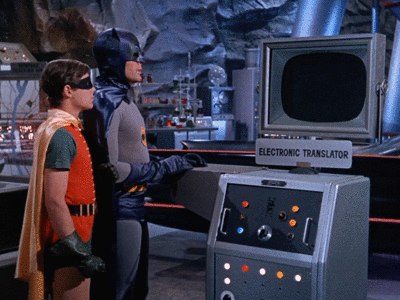
CLASS 04:
After we had a small conversation about our “translation” softwares in class, I thought it would be interesting to talk about how I use it in my everyday job as a French Translator for Jaguar Land Rover marketing content.
THE WHAT When I talk to my friends about the “machine” or “software” I use, you can tell it automatically sounds like there are no efforts into using this. They also often see our job as a little bit more inferior. People often ask “oh, so what do you do? Just translate?” I have to admit the “what” sounds a little boring when all people know about translation is Google Translate.
THE HOW However, once I take time to explain “HOW” we actually use SDL Trados, they are very impressed. The first thing I say, is that if you buy SDL Trados, it does not mean you can now translate and be a translator. *MUHP* It means you now have a tool to operate all of work in translation.
How it works is that, when I first started working for the marketing company, they did not have any “record” of their previous translations - this is called a “Translation Memory”, which is saved as a .sdltm file. In SDL Trados, when you create a Translation Memory, it first is empty - you need to add your own source to target sentences in it. After months of translating content (for me, it is marketing communications such as emails, website content, direct mail, radio and tv commercials, press releases, etc.), you find yourself with a “bank” of sentences used for the subject.
So basically, as you can see below, when you have enough in your translation memory, it will be able to tell you that you have already translated this sentence before, and it will populate YOUR OWN TRANSLATION you had done before. If the percentage is lower than 100%, it means that some words are differing in the source text. You can then adjust that and modify the target text so it matches:
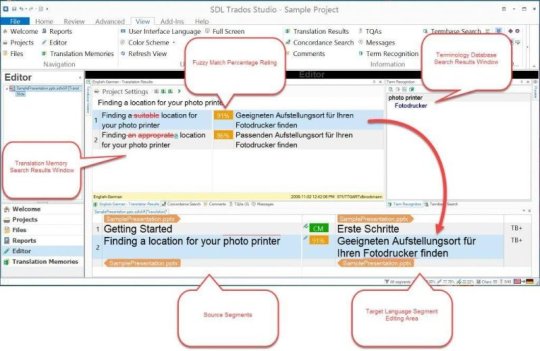
Why is this all linked to communication? Well, SDL is not only a software, but it is one of the most spread companies in the world - they operate in more than 40 countries and translate from hundreds of languages! But, it does not stop here! They also have other softwares such as “SDL Tridion” which is used for the creation of websites in many languages, allowing them to “localize” any content.
Why don’t people know more about SDL? Well, we could see them (and us translators) as the container for every translated content. For example, in Québec, we are so used to seeing everything in French with la Loi 101, but we do not realize that almost everything that we see or we read has been translated - and anything. It goes from your books in university to your training session, from the menu of big chains to the campaigns of your favourite prime minister... This is why the “background” is also important - because it allows you to appreciate the “text”.
1 note
·
View note
Text
A Higher Call?
2 weeks have past since trades phase and section training has been a bit more tiring due to the amount of prep and the timing we end. Was suppose to write this but I KO at about 11.15? And my mum was frustrated that I didn't off comp and light HAHAHA. I got recommended by my section instructor to be the Learning Sergeant Major (LSM), for those who do not know, it is basically company in charge. Compared to other LSMs before me, my job was more stressful due to the start of section training. First it was Basic Main Range (BMR), where we all had to refresh our gunnery brains and muscles and get all the maintenance items(OVM) and vehicles ready. The tough part wasn't the lesson, it's always always the OVM because we have to keep accounting for them, a total logistical nightmare. During the process of getting the vehicles ready, I had to keep track who has done what and whether they had already updated the board of their signal helmets and radio sets' serial number or not. Same for the weapon systems, testing the electrical cables and recording the serial number so that we can make sure that the items are 101% working with that same vehicle so that we don't waste time fixing if things go wrong. Lots of things to do and what can go wrong will go wrong! But nonetheless Polaris did it. Time came when we moved out to the range, and I can't emphasise how FRUSTRATING THAT WO KUANSHIN IS -.- to cut the story short: In the range: Range Sergeant Major (RSM) biggest, while LSM will support in counting strength. Guess what? HE KEEP LOOKING FOR ME -.- and end up instead of supporting... I did almost all the RSM job, THE RSM NEVER FIGHT FOR ME ALSO SIA-.- zzzzzzz I become R/LSM SUA LIDDAT. PEKCEK MAX. Not only that I had to deal with recovery after the range because when we reach company line, LSM resumes his status... LAME RIGHT? That Encik srsly... KEEP LOOKING FOR ME SIA IDK WHAT IS HIS PROBLEM. Other than that... BMR was a huge success! Thanks to the hard work Polaris put in together with the Gunnery Instructors:) Second, the start of section training. Come Monday when we started, it was self directed learning(SDL) the whole day, so I tot it was fine and all, and my thought was, section training rly that jialat meh, like Master Vincent said. So I just mentally prep myself a bit. Little did I know that things would get so messy. We were supposed to do up the groundsheet but then we had lots of OVM missing so we went to find it but to no avail, so end up we had routine orders(RO) at 10.15-20? I think. So I had everyone who were not involved in the OVM search before to copy down whatever SDL mentioned on the groundsheet so we would mess up as much... however come Tuesday, EVERYTHING IN THE MORNING WAS A HUGE MESS... ppl fall in late, ppl draw arms slow, most frustrating of all, WE DIDNT KNOW WHAT TO DO W THE OVM LAYOUT CUZ THERE WAS A FEW DIFF VERSIONS............... Stores weren't complete and appointment holders had to answer for them... hell of a day. So in the end the Instructors covered for us cuz they knew that their commands were also messy and they taught us how and what to do. Well at least I'm Glad that I didn't get knock down for nth cuz I got sth to learn. PLUS the change of command(COC) parade was on the same day but I told my Master (MSG) cannot cuz no time, so ended up I actually extended my duty for 3 days...(BETTER THANK ME HOR). Things got better only on Thursday and Friday when every ICs and my Learning Platoon Sergeants (LPS) knew what to do and we quickly deploy our men. That's when things were smooth, we met timings, and less confusion going on, and everything ended great on a Friday when I handed over my duty as the LSM to my section mate MARTINIE :) I'm sure he will do a good job knowing that he is a very hardworking person, even tho he rly sleeps a lot. Now when I think back, it is really a fruitful week, an amazing chance to take care of 68 men together with my other in charge, be it cadets or commanders. Rly a milestone of my army walk, now I can truly say that I have been in all roles before, Learning Section Commander(LSC), LPS and LSM. IN ADDITION! During my term as the LSM, I retook IPPT on Wednesday and my section Instructor, MSG Raymond keep telling me, "you can reach silver one la! My section left you Liao, I believe you can! 如果你跑不到12:30,我就杀了你。(If you can't run 12:30, I will kill you)" HAHAHA!!! I gave my best and ran 12:21!!!!! Push up maximum and sit up 40!!! That's a 75points just nice silver!!! Really thankful that I have a commander who kept believing in me and chose to push me on every round I go, I keep hearing ,"Lai chenhong run! Gogogo!" His good Friend SSG Long Fei was also there for me hahaha! Very touched by their actions and heart for cadets:) So in summary for this fruitful week: 1) A huge success(I feel) for my LSM term. 2) A Silver for IPPT Thankful for all who supported and it's my turn to support my Friend who I handed over as LSM :)
1 note
·
View note
Text






sdl ep. 101
#sueños de libertad#sdledit#suenos de libertad#mafin#mafinedit#marta de la reina#fina valero#marta x fina#sdl 101#by me#credits to tw/@_katewhistler for the ep.#***** knows how to do the **** ** ****** *** ***** perfectly.#NO COMMENT!!!!!!!!
120 notes
·
View notes
Text
Original Post from Microsoft Secure Author: Todd VanderArk
Zero Trust has managed to both inspire and confuse the cybersecurity industry at the same time. A significant reason for the confusion is that Zero Trust isn’t a specific technology, but a security strategy (and arguably the first formal strategy, as I recently heard Dr. Chase Cunningham, Principal Analyst at Forrester, aptly point out).
Microsoft believes that the Zero Trust strategy should be woven throughout your organization’s architectures, technology selections, operational processes, as well as the throughout the culture of your organization and mindset of your people.
Zero Trust will build on many of your existing security investments, so you may already have made progress on this journey. Microsoft is publishing learnings and guidance from many perspectives to help organizations understand, anticipate, and manage the implications of this new strategy. This guidance will continue to grow as we learn more. A few highlights include:
Maturity model—Describes the Zero Trust journey.
CISO Workshop Module 3: Identity and Zero Trust User Access—Learn how to advance Zero Trust with your identity and user access strategy.
Improve security with a Zero Trust access model—Microsoft Corporate Vice President and CISO, Bret Arsenault, describes how Microsoft is approaching Zero Trust with advice for applying learnings to your organization.
Zero Trust: A new era of security—E-book summarizing dynamics of Zero Trust and how Microsoft technology supports it today.
Zero Trust landing page—Overview and links to resources, assessments, etc.
In previous posts of this series, we described Microsoft’s vision for an optimal Zero Trust model and the journey of our own IT organization from a classic enterprise security to Zero Trust. Today, we focus on what a good strategy looks like and recommended prioritization (with a bit of history for context).
Zero Trust security continuously validates trustworthiness of each entity in your enterprise (identities, applications and services, devices) starting each with a trust level of zero.
Evolution of security strategy
The central challenge of cybersecurity is that the IT environment we defend is highly complex, leading security departments (often with limited budgets/resources) to find efficient ways to mitigate risk of advanced, intelligent, and continuously evolving attackers.
Most enterprises started with the use of a “trusted enterprise network,” but have since found fundamental limitations of that broad trust approach. This creates a natural pressure to remove the “shortcut” of a trusted enterprise network and do the hard work of measuring and acting on the trustworthiness of each entity.
Network or identity? Both (and more)!
The earliest coherent descriptions of the Zero Trust idea can be traced to proposals in the wake of the major wave of cybersecurity attacks. Beginning in the early 2000s, businesses and IT organizations were rocked by worms like ILOVEYOU, Nimda, and SQL Slammer. While painful, these experiences were a catalyst for positive security initiatives like Microsoft’s Security Development Lifecycle (SDL) and began serious discussions on improving computer security. The strategy discussions during this timeframe formed into two main schools of thought—network and identity:
Network—This school of thought doubled down on using network controls for security by creating smaller network segments and measuring trust of devices before network controls allow access to resources. While promising, this approach was highly complex and saw limited uptake outside a few bright spots like Google’s BeyondCorp.
Identity—Another approach, advocated by the Jericho Forum, pushed to move away from network security controls entirely with a “de-perimeterisation” approach. This approach was largely beyond the reach of technology available at the time but planted important seeds for the Zero Trust of today.
Microsoft ultimately recommends an approach that includes both schools of thought that leverage the transformation of the cloud to mitigate risk spanning the modern assets and (multiple generations of) legacy technology in most enterprises.
Prioritizing and planning Zero Trust
Microsoft recommends rigorous prioritization of Zero Trust efforts to maximize security return on investment (ROI). This default prioritization is based on learnings from our experience, our customers, and others in the industry.
Align strategies and teams—Your first priority should be to get all the technical teams on the same page and establish a single enterprise segmentation strategy aligned to business needs. We often find that network, identity, and application teams each have different approaches of logically dividing up the enterprise that are incompatible with each other, creating confusion and conflict. See the CISO workshop video, Module 3 Part 3: Strategy and Priorities, for more discussion of this topic.
Build identity-based perimeter—Starting immediately (in parallel to priority #1), your organization should adopt identity controls like Multi-Factor Authentication (MFA) and passwordless to better protect your identities. You should quickly grow this into a phased plan that measures (and enforces) trustworthiness of users and devices accessing resources, and eventually validating trust of each resource being accessed. See the CISO workshop video, Module 3 Part 6: Build an Identity Perimeter, for more information on identity perimeters.
Refine network perimeter—The next priority is to refine your network security strategy. Depending on your current segmentation and security posture, this could include:
Basic segmentation/alignment—Adopt a clear enterprise segmentation model (built in #1) from a “flat network” or fragmented/non-aligned segmentation strategy. Implementing this is often a significant undertaking that requires extensive discovery of assets and communication patterns to limit operational downtime. It’s often easier to do this as you migrate to the cloud (which naturally includes this discovery) than it is to retrofit to an existing on-premises environment.
Micro-segmenting datacenter—Implement increasingly granular controls on your datacenter network to increase attacker cost. This requires detailed knowledge of applications in the datacenter to avoid operational downtime. Like basic segmentation, this can be added during a cloud migration or a net new cloud deployment easier than retrofitting to an on-premises datacenter.
Internet first clients—A simple but significant shift is when you move client endpoints from being on the internet part-time to full-time (versus sometimes on corporate network and sometimes remote). This is a straightforward concept, but it requires having already established a strong identity perimeter, strong endpoint security and management over the internet, publishing legacy applications to your internet clients, dedicated administrative workstations, and potentially other initiatives before “rolling back” the firewalls from clients.
What good looks like
Zero Trust is a model that will ultimately be infused throughout your enterprise and should inform virtually all access decisions and interactions between systems.
Expanding on the three principles of Zero Trust from the Zero Trust vision paper—Verify Explicitly, Least Privilege Access, and Assume Breach—the hallmarks of a good enterprise Zero Trust strategy include:
Continuously measure trust and risk—Ensure all users and devices attempting to access resources are validated as trustworthy enough to access the target resource (based on sensitivity of target resource). As technology becomes available to do it, you should also validate the trustworthiness of the target resources.
Enterprise-wide consistency—Ensure that you have a single Zero Trust policy engine to consistently apply your organizations policy to all of your resources (versus multiple engines whose configuration could diverge). Most organizations shouldn’t expect to cover all resources immediately but should invest in technology that can apply policy to all modern and legacy assets.
Enable productivity—For successful adoption and usage, ensure that the both security and business productivity goals are appropriately represented in the policy. Make sure to include all relevant business, IT, and security stakeholders in policy design and refine the policy as the needs of the organization and threat landscape evolve. For more information, see Meet Productivity and Security Goals.
Maximize signal to increase cost of attack—The more measurements you include in a trust decision—which reflect good/normal behavior—the more difficult/expensive it is for attackers to mimic legitimate sign-ins and activities, deterring or degrading an attacker’s ability to damage your organization.
Fail safe—The system operation should always stay in a safe state, even after a failed/incorrect decision (for example, preserve life/safety and business value via confidentiality, integrity, and availability assurances). Consider the possible and likely failures (for example, mobile device unavailable or biometrics unsuccessful) and design fallbacks to safely handle failures for both:
Security (for example, detection and response processes).
Productivity (remediation mechanisms via helpdesk/support systems).
Contain risk of attacker movement into smaller zones—This is particularly important when you’re reliant on legacy/static controls that cannot dynamically measure and enforce trustworthiness of inbound access attempts (for example, static network controls for legacy applications/servers/devices).
Into the future
Over time, we expect Zero Trust will become accepted and commonplace where people simply learn it in “Security 101” (much like the least privilege principle today). Zero Trust is expected to evolve as we all become more comfortable with what this new normal entails and have ideas on how to optimize efficiency and address the attackers’ ongoing attempts to find a chink in the new armor.
Zero Trust
Reach the optimal state in your Zero Trust journey.
Learn more
Our next blog will discuss how to make Zero Trust real in your enterprise starting with technology available today, which you may already have deployed or have access to! In the meantime, bookmark the Security blog to keep up with our expert coverage on security matters. Also, follow us at @MSFTSecurity for the latest news and updates on cybersecurity.
The post Zero Trust strategy—what good looks like appeared first on Microsoft Security.
#gallery-0-5 { margin: auto; } #gallery-0-5 .gallery-item { float: left; margin-top: 10px; text-align: center; width: 33%; } #gallery-0-5 img { border: 2px solid #cfcfcf; } #gallery-0-5 .gallery-caption { margin-left: 0; } /* see gallery_shortcode() in wp-includes/media.php */
Go to Source Author: Todd VanderArk Zero Trust strategy—what good looks like Original Post from Microsoft Secure Author: Todd VanderArk Zero Trust has managed to both inspire and confuse the cybersecurity industry at the same time.
0 notes
Video
youtube
Novo TOYOTA COROLLA 2020 por R$ 99.990
O novo Toyota Corolla chegou com preço inicial de R$ 99.990 e pode chegar a R$ 131 mil na versão híbrida toda equipada. Confira os detalhes! TOYOTA COROLLA 2020 EQUIPAMENTOS Desde a versão de entrada GLi o modelo conta com ar-condicionado manual com filtro antipólen e ar quente, banco do motorista com regulagem para seis ajustes - altura, distância e inclinação – (também disponível na versão Altis híbrida), banco do passageiro dianteiro com regulagem manual para quatro ajustes (distância e inclinação), direção eletroassistida progressiva (EPS), computador de bordo com tela TFT de 4,2” de alta resolução, vidros dianteiros e traseiros com acionamento elétrico por um toque e função antiesmagamento e sistema de áudio central multimídia Toyota Play com tela sensível ao toque de 8”, rádio AM/FM, função MP3, entrada USB, Bluetooth, conexão para smartphones e tablets com Android Auto, Apple CarPlay e SDL. No que se refere a equipamentos de segurança, o Novo Corolla é o sedã médio com mais itens, com sete airbags, freios ABS com BAS e EBD, câmera de ré com linhas de distância com projeção na central multimídia, sistema ISOFIX para fixação de cadeirinhas no banco traseiro com ancoragem de três pontos, controle de estabilidade (VSC), tração (TRC) e assistente de partida em rampa (HAC), dentre outros. A versão XEi adiciona os seguintes itens: ar-condicionado automático, controle de velocidade de cruzeiro, modo de seleção de condução Sport, paddle shift, sistema de destravamento das portas por sensores na chave (Smart Entry), sistema de partida por botão (Start Button/Push Start), faróis de neblina dianteiros em LED e espelho retrovisor interno eletrocrômico. Já a versão Altis 2.0L Dynamic Force adota faróis dianteiros em LED e o exclusivo pacote de segurança ativa Toyota Safety Sense, que inclui Sistema de Alerta de Mudança de Faixa (Lane Departure Alert – LDA), Controle de Velocidade de Cruzeiro Adaptativo (ACC), Farol Alto Automático (Auto High Beam – AHB), e Assistente de Pré-Colisão (Pre-Crash System – PCS) com alerta sonoro e visual e, se necessário, frenagem automática (comandos podem ser controlados também pelo volante) Além disso, tem como item de série o pacote premium composto por: ar-condicionado automático Dual Zone com sistema S-Flow, banco do motorista com regulagem elétrica para oito ajustes (altura, distância, inclinação ou altura com distância), espelhos retrovisores externos eletro-retráteis com regulagem elétrica e rebatimento automático ao fechar o veículo, teto solar elétrico, limpador do pára-brisa com sensor de chuva e faróis e lanternas traseiras em LED. Na versão híbrida, o Altis conta com painel de instrumentos com tela TFT de 7” digital e colorida com computador de bordo e como opcional o pacote Premium descrito acima. O Corolla híbrido não conta com o paddle shift no volante. MOTORES - 2.0L Dynamic Force Dual VVT-iE 16V DOHC de ciclo Atkinson Flex, que rende 177 cv de potência a 6.600 rpm, quando abastecido com etanol, e 169 cv, a 6.600 giros, com gasolina. O torque máximo abastecido com etanol ou gasolina é 21,4 kgfm a 4.400 rpm. O Novo Corolla 2020 com motor 2.0L Dynamic Force também tem uma inédita transmissão Direct Shift de 10 marchas, que proporciona a suavidade de uma transmissão CVT convencional com uma sensação de aceleração direta. O sistema híbrido da Toyota, nesta nova geração do Corolla, combina um motor a gasolina de 1.8L VVT-i 16V de ciclo Atkinson flex, com 101 cv de potência a 5.200 giros quando abastecido com etanol, e 98 cv também a 5.200 rpm, quando abastecido com gasolina, e 14,5 kgfm de torque a 3.600 rpm (abastecido com etanol ou gasolina). Esse motor funciona em conjunto com dois motores elétricos (MG1 e MG2) de 72 cv de potência e 16,6 kgfm de torque.
0 notes
Text
Tax Invoices & Accounting Services Provider

What information needs to be on a Tax Invoice
The word “Tax Invoice” must be clearly indicated.
The supplier name, Address and VAT no
Tax Invoice Number
Date of Invoice
Recipient name, address and VAT number of recipient (if it is a registered vendor)
Description of goods
Price per unit and quantity
Total Sale value (Indicate the currency)
VAT Charged (indicate the VAT percentage)
Total value including VAT
For tax invoices below R5000
The recipient details need not appear on the invoice
There are no requirements to show the units or volume
The description need not be full.
Value Added Tax (VAT)
Who should register for VAT?
Any person that carries on a business may register for VAT.
It is mandatory for a person to register for VAT if the taxable supplies made or to be made is, in excess of R1 million in any consecutive twelve-month period.
A person may also choose to register voluntarily if the taxable supplies made, in the past period of twelve months, exceeded R50 000.
VAT increased from 14% to 15% from 1 April 2018.
How to register for VAT?
The VAT 101 application for registration must be submitted in person at the SARS branch nearest to the place where your business is situated or carried on.
A registered tax practitioner can register your business for VAT on your behalf.
Registering For Employees’ Tax [Pay-As-You-Earn (PAYE)]
Who should register as an Employer?
An employer must register with the SARS within 21 business days after becoming an employer, unless none of the employees are liable for normal tax.
What is Employees Tax?
Employees’ Tax refers to the tax required to be deducted by an employer from an employee’s remuneration paid or payable. The process of deducting from remuneration as it is earned by an employee is commonly referred to as PAYE.
Monthly submissions to SARS by Employer
The amounts deducted or withheld must be paid by the employer to SARS on a monthly basis, by completing the Monthly Employer Declaration (EMP201). The EMP201 is a payment declaration in which the employer declares the total payment.
Employer Annual Reconciliations
Employers are required to submit their Employer Annual Reconciliations by 31 May to SARS, confirming or correcting payroll tax amounts which were declared in respect of the tax period.
Who should register for Unemployment Insurance Fund (UIF)
An employer who is registered or required to register with SARS for PAYE and/or Skills Development Levy (SDL) purposes, is also required to register with SARS for the payment of Unemployment Insurance Fund (UIF) contributions to SARS.
#taxservices#taxation#pretoria#northpretoria#accountants#bookkeepers#bookkeeping#accounting#southafrica
0 notes
Text
Windows 101 + ALL The Details on The Merc Windows!
Thanks to Home Depot and Andersen Windows for partnering with me on this post!
Guys, are you ready to dive into the world of windows? This is a whole universe that I had very little knowledge of before I had to pick windows for the Merc and now I have enough knowledge to not sound like an idiot when I’m talking to the contractors…so um, basically an expert.
It was very important for me to match the original style of the windows at the Merc. They are such a huge part of the personality of any house and have so much weight with how the style shakes out. When you’re building or remodeling a house DO NOT forget about the windows or just let your builder order the most budget friendly option that will disappear. A little design elevates the entire space in ways that nothing else can. Here’s a fun challenge, look at your pinterest boards, especially when you’re looking at the images of house exteriors. How many of the homes you have pinned have basic builder grade sliding windows? Probably not many. Windows matter guys. But not only do they need to look good, they need to be incredibly functional.
There are a lot of window companies in the world, for our windows we chose to go with Andersen A-Series. Andersen has an incomparable reputation, you can customize things to an extreme degree (it’s intense and exciting!), they’ve got killer energy efficiency, and they are sold at Home Depot (which means you can get them ANYWHERE!) #homedepotforlife If you know me, or if you’ve ever had a conversation with Court you know that I am very much a form over function person, I want it to look good first. The great thing about Andersen is that you don’t have to choose one or the other. Everything is beautiful, everything is functional, and honestly does it get much better than that? (Maybe if they did my laundry, but other than that, nope!) I did A LOT of research on windows before I decided to partner with Andersen on this part of the Merc reno and I can say with complete confidence that they are the gold standard.
There is a lot of info to share about what we chose and why, so hang in there with me as I try to explain it in a way that gives you all the important info without sounding like the teacher on Charlie Brown. The great thing is that depending on the style of your house, the climate you live in, and your budget they have options for all of it.
Alright, lets get started!! First we’re going to talk about the function specifics and then we’ll dive into the design.
Divided light, colonial, industrial, grids, mullions, grills, big windows with smaller ones inside. You know where this is going right? There are a million different names to describe windows that look like this:
The correct way is Divided Light. There are subsections but they all exist under the divided light umbrella.
True Divided light (TDL) which means that the small square or rectangle panes are actually separate windows, all joined together in a bigger window. This is historically very accurate (as this is how the original windows at the Merc are, but its not very energy efficient and not readily available.
Full Divided Light (FDL) This is the option I chose! Full Divided light is the best of both worlds, grilles are applied to the interior and exterior of your window with an aluminum spacer between the glass. An Energy Spacer option is also available to help achieve Energy Star rating. We chose the Energy Spacer because of our extreme summers (we’ll talk about other choices we made to help with energy efficiency too.) The Energy Spacer sort of floats between the pieces of glass so nothing is sectioned off completely. It’s really cool technology and looks great.
Simulated Divided Light (SDL), which is where the glass is one large piece and looks divided because of mullions on the exterior of the glass.
Grills between Glass that is where the grill is placed in-between the 2 sides of the glass instead of the outside. This makes it easier to clean because its just one large surface.
One of the things that was super important for us was the energy efficiency. The Merc is pretty large, and obviously very old so we’re doing everything we can to cut back on our electrical consumption. Andersen has 7 different glass options. SEVEN. They don’t even have that many options of M&M’s guys. We live in Southern Utah and its nice and toasty for most of the year. In this portion of the renovation we have 2 windows that face east and 2 that face south (excluding our OG storefront windows on the north) For our south facing windows we used Low-E glass. Low-E glass reflects heat in the summer and helps keep heat inside in the winter, making this a good choice in climates where both heating and cooling costs are a concern. Its the best standard baseline option with great energy efficiency. For our eastern facing windows I chose to use SmartSun glass. SmartSun glass gives you the benefits of Low-E glass, plus it helps shield your home from the sun’s heat and filters out 95% of harmful UV rays without altering the color of the glass with a tint. Brilliant right?! We’ll definitely be using this on the western side when we start Phase 2.
Another reason I was so excited to have Andersen windows is because of their VeriLock tech. VeriLock security sensors will not only tell you if your window is open, but also if it’s unlocked!! No other sensors can do that, its a big deal. Just think, no more panic 3 hours into your vacation and trying to track someone down that can make sure you locked your windows!!
Ok lets talk design!! Andersen A-Series was designed with specific styles in mind. Check out their Home Style library (you’ll want to click into every style, just a fair warning). There are 14 house styles represented (with more being added all the time) and they tell you the exact recipe for the windows that match that style. Love Farmhouse? Craftsman? Industrial? Modern? They’ve got it all figured out for you. How great is that?!
There are 7 typical window types. In the Merc we used 3 of them. Fixed, Casement, and Double Hung.
Fixed means that the windows don’t open at all. It is purely there for light. We put a fixed window in our laundry/mud room They are usually the most budget friendly option. (I think we’ll do a bunch of fixed in Phase 2. #budget)
Casement windows open the way that a door does. They are hinged on one side and latch on the other. They typically swing outside the building so if you use a screen its on the inside of the window. When they are closed they look like fixed windows. We used this type in the back bedroom because it is next to the fixed window on the back of the building. Casement windows are typically the most expensive style.
Double Hung windows are 2 windows that meet in the center. The bottom one slides up, and the top one can slide down (as opposed to a single hung where only the bottom window can slide up). These are the type we used in the 2 east facing bedrooms.
The grille pattern that we chose was Colonial, with Andersen you can decided exactly how you want it divided up, so we sectioned it off so that the size of each pane was the same as the original (or at least the same scale). Its a small detail that will make everything flow together so perfectly.
There are loads of finish options for the interior and exterior (you can choose the colors seperately!) I chose black for both. We all know how picky I am about my black paint and I’m happy to report that its a seamless color transition between the windows (that came pre-painted) and the trim that we installed and painted ourselves.
The first thing that people comment on when they’re getting a Merc tour are our windows, they are absolutely stunning. If you are in the market for windows I HIGHLY HIGHLY recommend heading to andersenwindows.com and designing your windows. Then print off your specs, gather your measurements, and take them to your local Home Depot to order.
Here’s the TLDR specifics on our windows
Andersen A-Series Fixed, Casement, Double Hung Full Divided Light with Energy Spacers Low-E + SunSmart Glass Colonial Grille Pattern Black Painted Interior and Exterior VeriLock Sensors
The post Windows 101 + ALL The Details on The Merc Windows! appeared first on Vintage Revivals.
Windows 101 + ALL The Details on The Merc Windows! published first on http://ift.tt/2hUI8pL
0 notes
Text
Novo Corolla 2020: Sempre à frente
Tempo de leitura: 4 minutos
A Toyota apresentou o décima segunda geração do carro mais vendido do mundo, o Toyota Corolla 2020. Produzido em Indaiatuba/São Paulo, o modelo chega as concessionárias ainda no mês de setembro. São três versões de acabamento e duas de motorização.
O grande trunfo da montadora é apresentar Novo Corolla como o primeiro sedã híbrido flex no mundo. Isso significa que o modelo se abastece de energia elétrica, além de gasolina e etanol em qualquer proporção.
Neste post blog, vamos conhecer mais sobre os detalhes do Corolla 2020
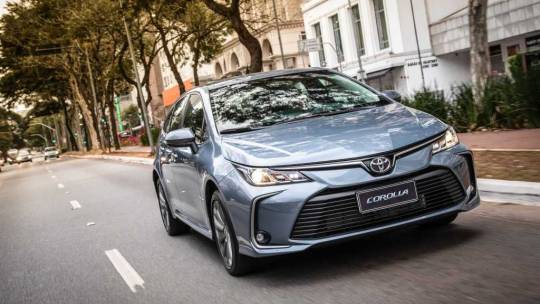
Exterior do Novo Corolla 2020
O modelo possui 4.630 mm de comprimento, 1.780 mm de largura e 1.455 mm de altura. A distância entre eixos é de 2.700 mm. Para armazenar o combustível, existem tanques de 43, para a versão de combustão e 50 litros para a versão híbrida.
Se tratando de design, o Novo Corolla tem grade frontal cromada se combina harmoniosamente aos faróis dianteiros de LED com luzes diurnas (DRL) que conferem forte identidade ao modelo. Linhas laterais contínuas conectam a parte dianteira às lanternas traseiras de LED de forma fluída, conferindo dinamismo.
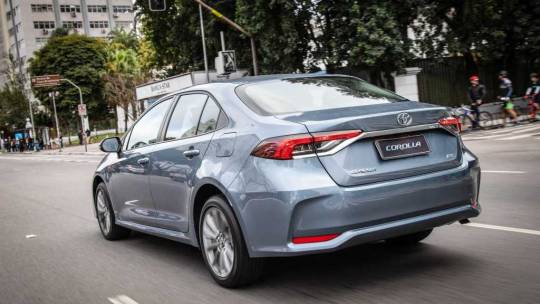
Os espelhos retrovisores externos elétricos são na cor do carro e contam com pisca integrado. Rodas de liga leve aro 17″ com acabamento na cor prata completam o acabamento externo.
Interior do Novo Corolla 2020
Para dar mais sofisticação ao modelo, o interior do Novo Corolla tem bancos com partes revestidas de couro (lateral do acento e lateral do encosto dos bancos dianteiros e o volante).
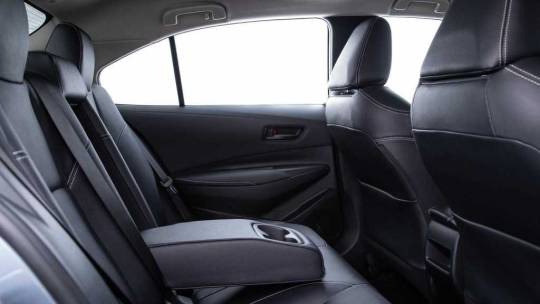
As partes revestidas de material sintético derivado de PVC (parte traseira e ombro dos bancos dianteiros, laterais dos bancos traseiros e apoios de cabeça dianteiros e traseiros).
O modelo também possui partes revestidas de tecido (encosto e acento central dos bancos dianteiros e traseiros). Acabamento interno com revestimento de couro (volante), e partes revestidas de material sintético derivado de PVC (manopla de transmissão, apoio para braços central e portas.
O painel central é na cor Black Piano. O sistema multimídia é o Toyota Play+ com tela sensível ao toque de 8″, rádio AM/FM, função MP3, entrada USB, Bluetooth® e conexão com smartphones e tablets através de Android Auto®, Apple CarPlay® e SDL.
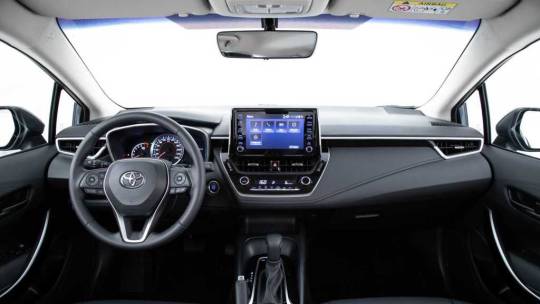
Para facilitar a experiência do usuário o modelo conta com ar condicionado automático digital frio e quente com filtro antipólen. O banco do motorista conta com 6 ajustes de altura, distância, inclinação. Já o banco do passageiro conta com 4 ajustes de inclinação e altura.
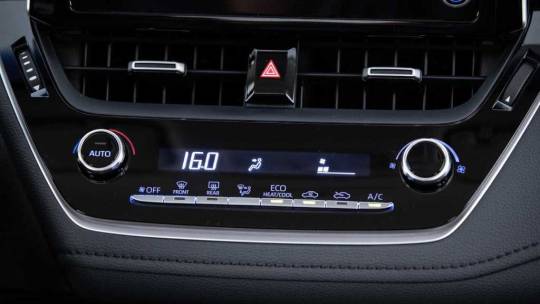
E ainda possui computador de bordo com visor multifunção e tela TFT de 7,0” digital e colorida. Indicador de direção econômica no painel de instrumentos (Hybrid System). Start Button/Push Start e Smart Entry.
Plataforma TGNA
A Toyota investiu cerca de R$ 1 bilhão para produizir o Novo Corolla sob a plataforma global TNGA. A montadora garante que o modelo obterá nota máxima nos teste de segurança do Latin NCAP.
A respeito do que é a plataforma TGNA, Tom Burrows, gerente de produção, projeto e e qualidade veicular da Toyota diz que: “A TNGA representa uma mudança total de pensamento na Toyota. É uma oportunidade para designers e engenheiros pensarem e criarem o melhor carro possível na melhor fábrica possível”.
Versões do Novo Corolla
Corolla Gli – Motor: 2.0L Dual VVT-iE 16V DOHC Flex (Dynamic Force), com 177 cavalos de potência e 21,4 Kgf.m de torque (abastecido 100% com etanol).
Transmissão: Automática – Direct Shift CVT com modo sequencial de dez velocidades.
Corolla Xei – Motor: 2.0L Dual VVT-iE 16V DOHC Flex (Dynamic Force), com 177 cavalos de potência e 21,4 Kgf.m de torque (abastecido 100% com etanol).
Transmissão: Automática – Direct Shift CVT com modo sequencial de dez velocidades, paddle shift no volante e botão seletor de modo de condução Sport.
Corolla Altis Premium – Motor: 2.0L Dual VVT-iE 16V DOHC Flex (Dynamic Force), com 177 cavalos de potência e 21,4 Kgf.m de torque (abastecido 100% com etanol).
Transmissão: Automática – Direct Shift CVT com modo sequencial de dez velocidades, paddle shift no volante e botão seletor de modo de condução Sport.
Corolla Altis Hybrid – Motor: Sistema Híbrido Flex com 101 cavalos de potência no motor a combustão e 72 no motor elétrico. Torque de 14,5 Kgf.m no motor a combustão (abastecido 100% com etanol) e 16,6 Kgf.m no elétrico.
Transmissão: Automática – Hybrid Transaxle CVT com botão seletor: Normal, ECO, Power e EV (Electric Vehicle).
O Novo Corolla 2020 já está disponível para reserva no Portal Carlider. Reserve já o seu!
Confira nosso site para ver os mais diversos veículos e marcas. Também acompanhe nosso Facebook para ficar por dentro das nossas dicas e novidades do mercado de automotivo.
O post Novo Corolla 2020: Sempre à frente apareceu primeiro em O Blog do Carro - Carlider.
http://blog.carlider.com.br/2019/09/13/novo-corolla-2020/ originado em http://blog.carlider.com.br
0 notes